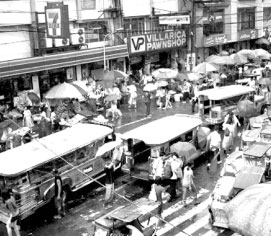Quality, not size matters
When it comes
to development, it is not the scale of economic growth but its nature
that is important.
The Philippines needs a post-2015 development agenda that reclaims
human rights as the normative framework, especially ensuring the right
to education, health and decent work, and addressing the long-standing
inequalities, concludes the report 2013 of Social Watch-Philippines.
 Economic growth averaged 4.7 percent a year since 2000 in this South
Asian country, but only the elites harvested the benefits, while poverty
increased to reach more than one of every four Filipinos, says the
study. Economic growth averaged 4.7 percent a year since 2000 in this South
Asian country, but only the elites harvested the benefits, while poverty
increased to reach more than one of every four Filipinos, says the
study.
“It is not so much the size of the economic growth, but its nature
that matters,” said Marivic Raquiza, main author of the report.
Social Watch-Philippines emphasizes that an effective post-2015
framework for development must include the completion of the agrarian
reform, a brand new progressive taxation system and the revitalisation
of the manufacturing sector to ensure the creation of quality jobs. In
the global level, a new financial architecture is required to provide
adequate policy space for this and other countries to independently
chart its own development agenda.
The 2011-2016 Philippine Development Plan proposes an inclusive
growth, defined as sustained, high growth that generates mass employment
and reduces poverty. This is to be achieved, according to President
Benigno Aquino, by “improving transparency and accountability,
strengthening the macro-economy, boosting the competitiveness of
industries, facilitating infrastructure development, strengthening
financial sector and capital mobilisation, improving access to quality
services, enhancing peace and security for development and ensuring
ecological security.”
But the United Nations, civil society organisations and social
movements has described the Philippines’ performance regarding the MDGs
as dismal.
Poverty incidence for the first time increased from 2003 at 24.9
percent to 26.4 percent in 2006 and then to 26.5 percent in 2009. In the
meantime, poverty also worsened for young people, migrants and formal
sector workers (each with 1 percent increase), and children and
individuals in urban areas (with 0.3 percent increase), according to
official statistics.
The poorest people are fisherfolk (41.4 percent farmers (36.7 percent
and children (35.1%). In the past decade, economic growth has not
benefited those who need it most, warns the report. In 2011, gross
domestic product increased by USD 17 billion; in the same year, the
wealth of the 40 richest Filipinos rose by USD 13 billion (37.8 percent
in total). “Little wonder why the country’s Gini co-efficient - at .44 -
is among the highest in Southeast Asia,” remarked Raquiza.
The Philippine unemployment rate has stagnated in the last five years
at 7 percent underscoring that this indicator is not sensitive to
changes in labour trends because the country’s labour force is
significantly composed of self-employed workers and unpaid family
workers. But the high averaged underemployment rate (22.7 percent is an
even more meaningful indicator, because most people do not have access
to social protection.
Although the agricultural sector has shrunk (from 25.1 percent of GDP
in 1980, to 12.8 percent in 2011), and the labour-intensive nature of
the industrial sector has high employment potential, including for the
less-skilled workers, the manufacturing sector has declined (from 25.7
percent of GDP in 1980, to 19.4 percent in 2011), while the services
sector is burgeoning (from 36.1 percent of GDP in 1980 to 55.7 percent
in 2011).
“The government’s development strategy is essentially ‘business as
usual’: remaining focused on ‘growing the pie’,” adds Raquiza.
“In this vision, the role of the private sector is enhanced”, but the
public-private partnerships program “was very slow to start and as a
result, as of this writing, is still in the early stages of project
development,” wrote Raquiza.
In the meantime, the lion’s share of the social protection budget is
devoted to the Pantawid Pamilya Pilipino Program, patterned after those
conditional cash transfer plans implemented in Mexico, and Brazil. Its
allocation has been dramatically increasing every year since the program
started in 2007, but the program is partially funded on loans from the
World Bank and the Asian Development Bank, which raises questions about
its financial sustainability.
– Third World Network Features.
|



